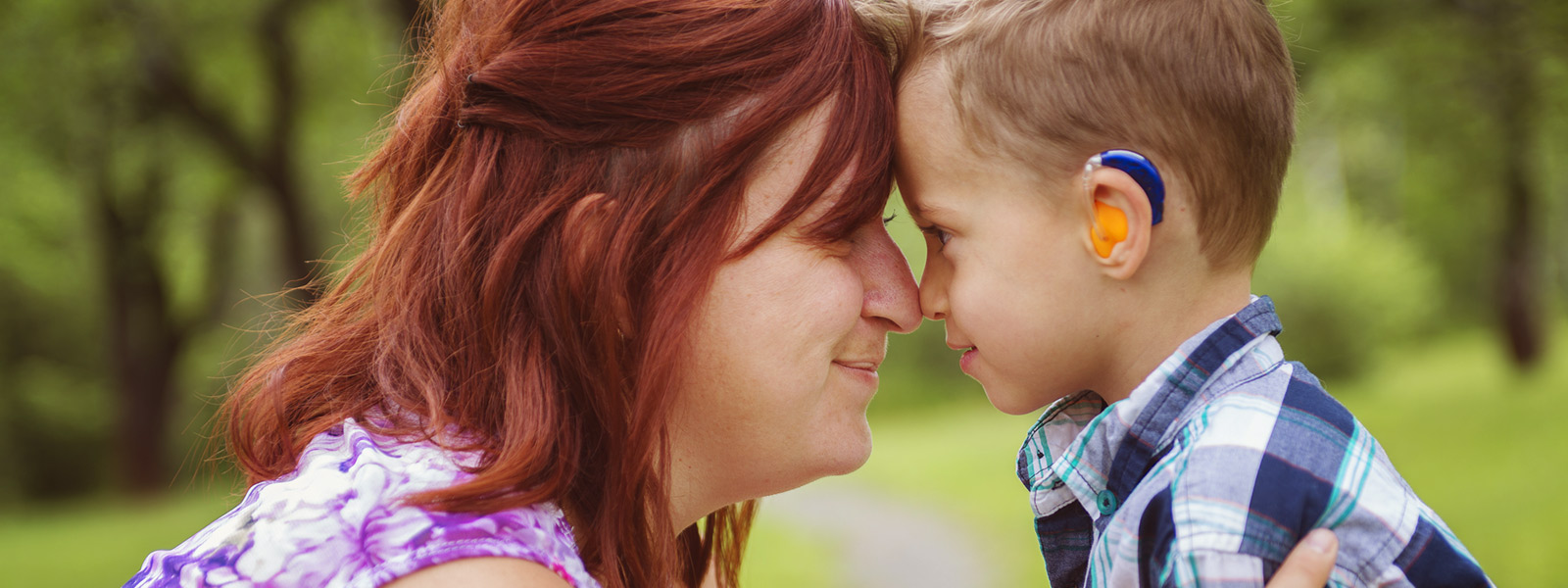
Hearing Impairment
Did you know?
There are approximately 9 million people in the UK with deafness ranging from mild to profound.
Approximately 1 in every 1000 children are born with a severe or profound hearing loss 90% of all deaf children are born to hearing parents.
What is deafness?
The term ‘deaf’ can be used to describe all levels of hearing loss in children, including a partial or total loss of hearing. This includes those who may describe themselves as having a ‘hearing loss’, ‘hearing impairment’ and includes children who may have a temporary deafness such as glue ear.
Main types of deafness
- Sensorineural deafness is a hearing loss in the inner ear. This usually means that the cochlea in the inner ear is not working effectively.
- Conductive deafness means that sound cannot pass efficiently through the outer and middle ear into the inner ear. This is often caused by blockages such as wax in the outer ear, or fluid in the middle ear (glue ear). Glue ear is a very common condition, especially in pre-school children.
It is possible for children to have a combination of sensorineural and conductive deafness. This is known as mixed deafness.
Most deaf children can hear some sounds at certain frequencies and loudness, and with the use of hearing aids they are often able to hear more sounds.
Indicators of Hearing Loss
- Does not respond when called
- Hears name and simple instructions but little else
- Misunderstand or ignores instructions
- Frequently asks for repetitions
- Reluctant to speak freely – nods or shakes head rather than says ‘yes’ or ‘no’
- Speaks very softly (conductive hearing loss)
- Shouts or talks loudly (mild sensori-neural loss)
- Appears dull / uninterested / withdrawn into own private world
- Behaviour problems, may be naughty or disruptive in class
- Struggles at school in reading and verbal subjects
- Persistent colds/catarrh
- Earache
- Discharge from ears
- Speech problems
- Family history of deafness
Glue Ear
Glue ear is one of the most common childhood illnesses.
Children under the age of five mostly commonly experience glue ear but it can carry on into the teenage years. Glue ear can cause temporary deafness, delayed speech development and affect children’s behaviour and their learning in school.
Glue ear can often be linked with ear infections and can develop unnoticed. Changes in behaviour, becoming tired and frustrated, lack of concentration, preferring to play alone and not responding when called may indicate glue ear. As a result some children with glue ear are misunderstood or labelled as ‘difficult’.
The role of Speech and Language Therapist with deafness
Developing good language skills right from birth is very important for deaf children. Learning to play, listen and interact will all have a big impact on speech and language development.
A Speech and Language Therapist may be involved in lots of different ways. They may:
- Work jointly with other professionals such as the Teachers of the Deaf, Audiologist and educational professionals to help advise on the best language environment for your child
- Monitor and assess your child’s speech and language development
- Give parents/carers advice and guidance about the best ways to communicate with their child
- Provide ideas and model activities to help develop listening, speech and language skills
- Contribute reports that may be part of a multiagency management of your child
- Provide therapy to develop your child’s speech and language skills
Top Tips for communicating with your child
Every child is different and may need a different approach depending on their preferred way of communicating and their level of deafness:
- Find out the best way to communicate. Is it sign language, oral language or both?
- Get their attention – can they see you properly?
- Make lip- reading easy. Speak clearly and naturally with mouth uncovered and in a good light.
- Get down to the child’s level
- Speak one person at a time. Group conversations can be difficult for deaf children
- Making the topic clear…’ we are talking about…’
- Ensure you have the best listening environment.- reduce background noises.
- Are hearing aids on? Are they working?
- Use natural gesture and visual cues to support communication
- Be imaginative.. Draw it.. write it… don’t give up! (Taken from leaflet’ Communicating with Deaf Children’ – National Deaf Childrens Society)
If you are concerned about your child’s hearing, speak to your Health Visitor or GP who will be able to refer you for a hearing test.
Further Information
- The National Deaf Children’s Society has a range of resources to support families with language and communication. It has special pages written for children and young people www.ndcs.org.uk. Freephone helpline 0808 800 8880
- Ewing Foundation is a national charity promoting inclusion and achievement of deaf children through listening and speaking www.ewing-foundation.org.uk
- Auditory Verbal Therapy is a specific therapy which is a parent-coaching programme which develops spoken language through listening www.avuk.org
- www.cochlear.com
- www.cafamily.org.uk contact a family – for families with children who have a disability)
- www.kidsaudiologist.info
- www.heartogether.org.uk

